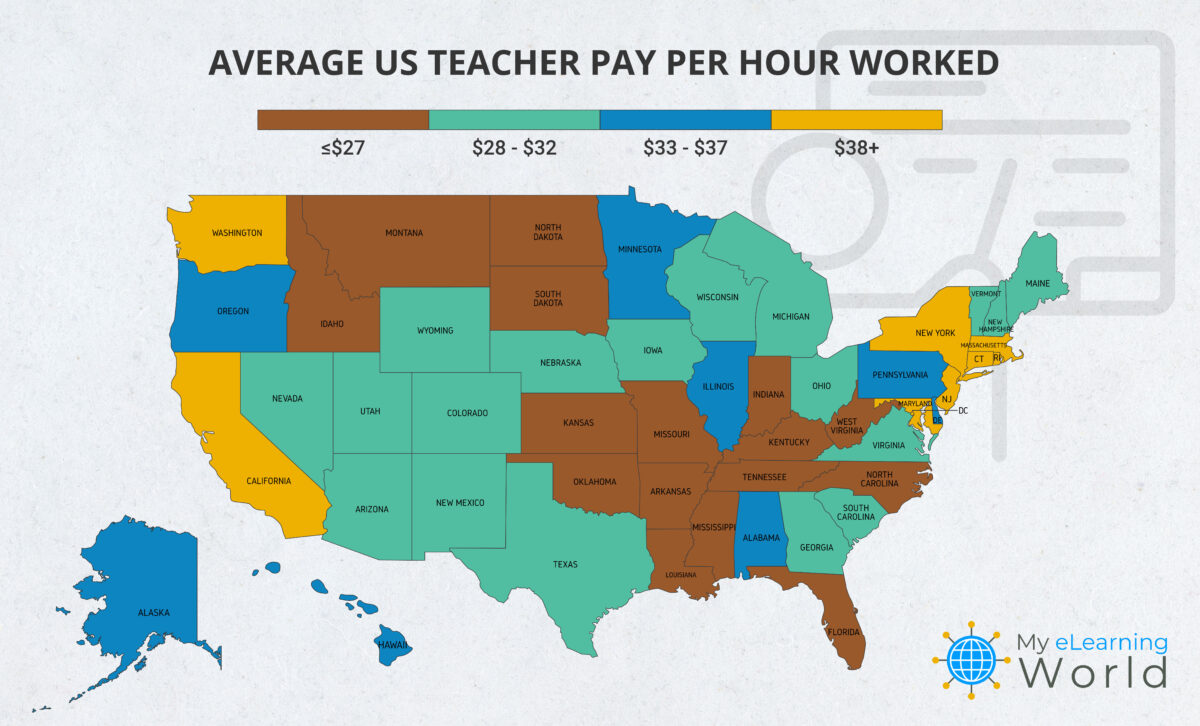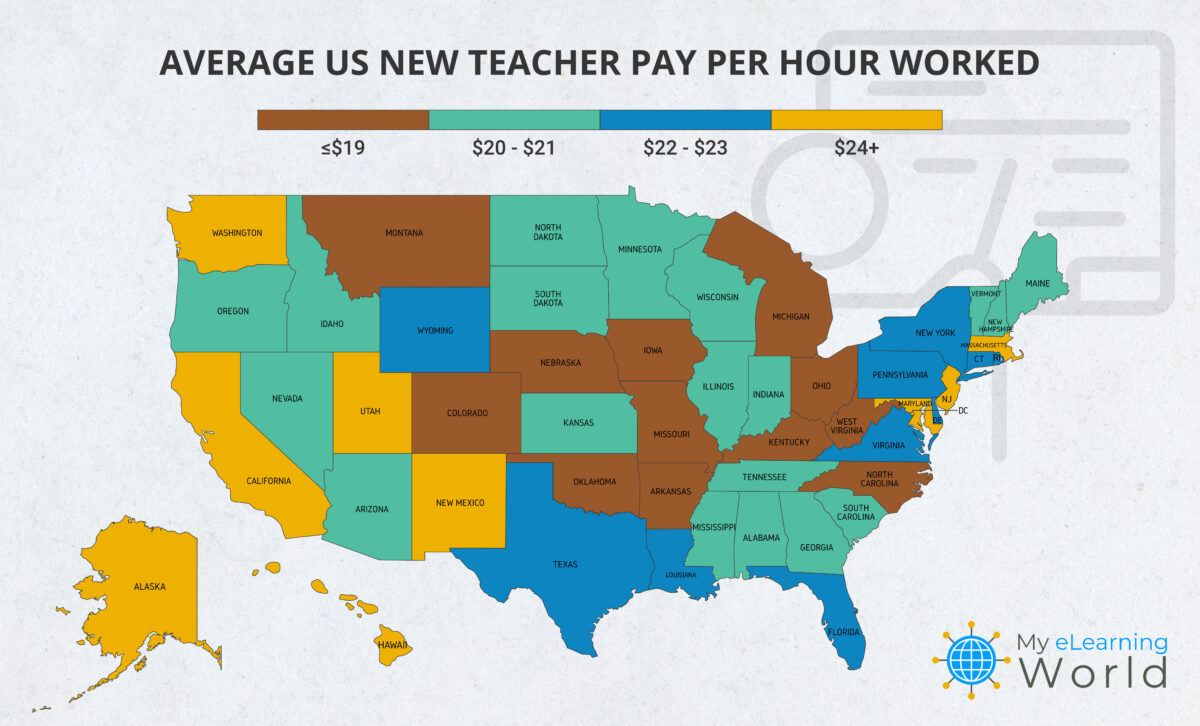Across the United States, schools struggling to fill teaching vacancies, and one of the biggest reasons for the shortage is that teachers, especially newcomers to the profession, just aren’t earning enough to attract talent to the field.
Last month, we released a report showing that new teachers in the U.S. earn approximately 20% less in real terms than they did two decades ago, failing to keep pace with inflation. But our latest study reveals that the problem is even worse than it appears on its surface when you consider the additional long additional hours that teachers typically work outside of the classroom. These hours include lesson planning, grading, professional development, and participating in student activities, which effectively lowers their real hourly wage even further, making the financial struggles for educators more severe than initially apparent.
Our analysis finds that the average US teacher works 2,100 hours in a full calendar year — based on that, first-year teachers earn an average of only $21 per hour worked, while the average across all teachers is $31 per hour.
According to Statista, the average hourly earnings for all employees in the US was $34.69 in March 2024.
Not only that, first-year teachers make about 28% less than the average new college graduate, meaning that teachers earn significantly less than the national average for all occupations, despite the critical role they play in shaping future generations and the demanding nature of their work.

The financial hardships facing teachers have started to result in declining enrollment rates in education programs across the country as many young adults don’t see the profession as financially viable or rewarding enough to sustain a long-term career. Several universities, including Harvard, Oklahoma City University and New Jersey City University, have even shuttered their undergraduate teaching programs due to a lack of sustainable enrollment.
Consider this — 50 years ago, 21% of all bachelor’s degrees were in education; that number has plummeted to just 4.4% today.
Recent data also shows that roughly one-third of US K-12 teachers are seriously considering leaving the profession, with many taking their skillset to corporate settings like instructional design, corporate training, and other roles that offer more lucrative career opportunities.
RELATED: How to Make the Transition from Teacher to Instructional Designer
“The teacher shortage we’re experiencing is a national emergency that demands immediate attention. The gap between the number of necessary qualified teachers and those entering the field is growing rapidly, and low teacher pay is a huge reason we’re experiencing this,” said Scott Winstead, founder of My eLearning World. “By offering more competitive pay, we can attract passionate and talented individuals to education and ensure that our students receive the high-quality teaching they deserve.”
In response to the crisis, lawmakers in 23 states have proposed measures to improve teacher compensation. These initiatives range from raising minimum salaries and providing annual bonuses to offering extra support for special education teachers and paraeducators, signaling a legislative acknowledgment of the need for reform.
These legislative measures provide a ray of hope, but a lot remains to be accomplished to fully resolve the issue.
Moving forward, it’s critical that policymakers, educators, and the community persist in their efforts to advocate for equitable teacher compensation, especially when considering the effective hourly pay, which remains alarmingly low.
Paying teachers a wage that truly reflects their invaluable role in society is the only way to attract and retain skilled educators who can deliver the high-quality education our students need and deserve.
See the full state-by-state data for real hourly earnings below.
New US Teacher Hourly Pay by State
| State | Hourly Pay |
| Alabama | $21 |
| Alaska | $24 |
| Arizona | $21 |
| Arkansas | $18 |
| California | $26 |
| Colorado | $19 |
| Connecticut | $23 |
| Delaware | $22 |
| District of Columbia | $30 |
| Florida | $22 |
| Georgia | $20 |
| Hawaii | $24 |
| Idaho | $20 |
| Illinois | $21 |
| Indiana | $20 |
| Iowa | $19 |
| Kansas | $20 |
| Kentucky | $19 |
| Louisiana | $22 |
| Maine | $20 |
| Maryland | $25 |
| Massachusetts | $24 |
| Michigan | $19 |
| Minnesota | $21 |
| Mississippi | $20 |
| Missouri | $18 |
| Montana | $16 |
| Nebraska | $18 |
| Nevada | $21 |
| New Hampshire | $20 |
| New Jersey | $27 |
| New Mexico | $24 |
| New York | $23 |
| North Carolina | $19 |
| North Dakota | $20 |
| Ohio | $19 |
| Oklahoma | $18 |
| Oregon | $20 |
| Pennsylvania | $23 |
| Rhode Island | $22 |
| South Carolina | $20 |
| South Dakota | $20 |
| Tennessee | $20 |
| Texas | $22 |
| Utah | $24 |
| Vermont | $21 |
| Virginia | $22 |
| Washington | $26 |
| West Virginia | $19 |
| Wisconsin | $20 |
| Wyoming | $23 |
Average US Teacher Hourly Pay by State (All Experience Levels)
| State | Hourly Pay |
| Alabama | $33 |
| Alaska | $36 |
| Arizona | $29 |
| Arkansas | $26 |
| California | $45 |
| Colorado | $29 |
| Connecticut | $40 |
| Delaware | $33 |
| District of Columbia | $40 |
| Florida | $25 |
| Georgia | $31 |
| Hawaii | $34 |
| Idaho | $27 |
| Illinois | $35 |
| Indiana | $27 |
| Iowa | $29 |
| Kansas | $27 |
| Kentucky | $27 |
| Louisiana | $26 |
| Maine | $29 |
| Maryland | $38 |
| Massachusetts | $44 |
| Michigan | $32 |
| Minnesota | $33 |
| Mississippi | $25 |
| Missouri | $26 |
| Montana | $27 |
| Nebraska | $28 |
| Nevada | $29 |
| New Hampshire | $31 |
| New Jersey | $39 |
| New Mexico | $30 |
| New York | $44 |
| North Carolina | $27 |
| North Dakota | $27 |
| Ohio | $32 |
| Oklahoma | $26 |
| Oregon | $35 |
| Pennsylvania | $36 |
| Rhode Island | $38 |
| South Carolina | $28 |
| South Dakota | $25 |
| Tennessee | $26 |
| Texas | $29 |
| Utah | $30 |
| Vermont | $32 |
| Virginia | $30 |
| Washington | $41 |
| West Virginia | $25 |
| Wisconsin | $30 |
| Wyoming | $30 |

